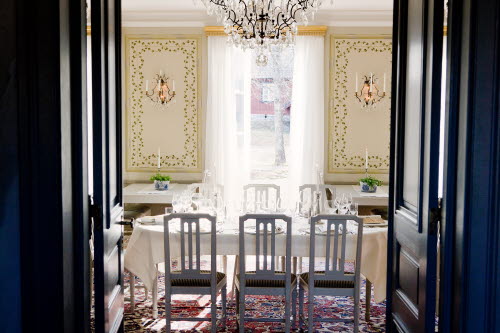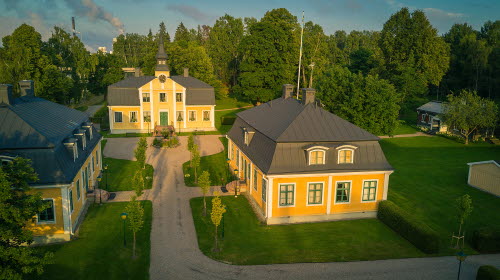The Grill Manor is closely associated with the mill's development in Iggesund, founded in 1685 as an ironworks. The manor house was built in 1724 on the old house's foundation, which had been burned down, and meticulously restored to recreate the original wall coverings and colour scheme as closely as possible.
The small manor house was once situated at the head of a works road lined with low, uniform worker’s dwellings and faced the works’ furnace and smithies. Its use has changed over the centuries, but following an extensive renovation in the 1960s, the Grill Manor became a guesthouse for the mill in Iggesund, primarily used by the customers in conjunction with their visits to the company.
In addition to the hospitality provided by Tobbe Johansson, Head of the Guesthouse, and his team, customers staying at the Grill Manor get to experience the culinary craftsmanship of the kitchen through contemporary food with carefully selected ingredients.

The Grill Manor's dining room.
The main building is kept in a condition that reflects Swedish country house tradition and the mill's history. With a simplicity typical of northern Sweden, the manor house is a perfect example of a gentleman’s country estate from the Caroline period and the Age of Liberty. The manor’s two wings were constructed simultaneously as the main building. At first, they were single-storey, but another storey was added in conjunction with a renovation in 1760.
The south wing, which now houses rooms for guests, was used for many years as an office by the mill in Iggesund. The north wing was the residence of the ironworks inspector and has also been used as a residence for other senior officials. At times, the wing also housed the manor house’s bake oven and kitchen. In former times, it was common for food preparation to take place in a separate building because of the risk of fire. In the early 20th century, the mill in Iggesund’s laboratory was also housed in part of this wing.

The Grill Manor in the 2010s.


